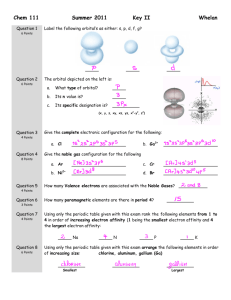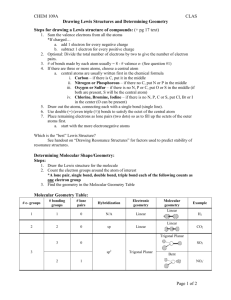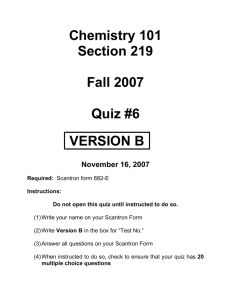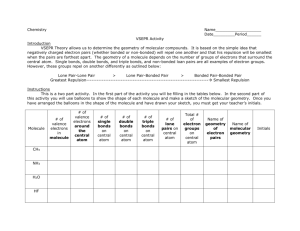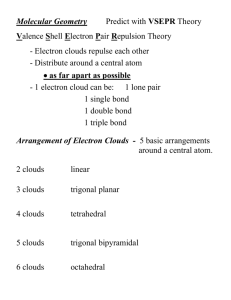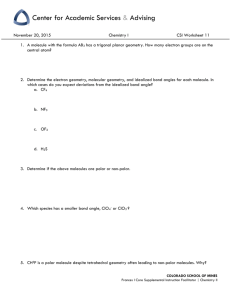Lewis Dot Structures, VSEPR, and Geometries of
advertisement
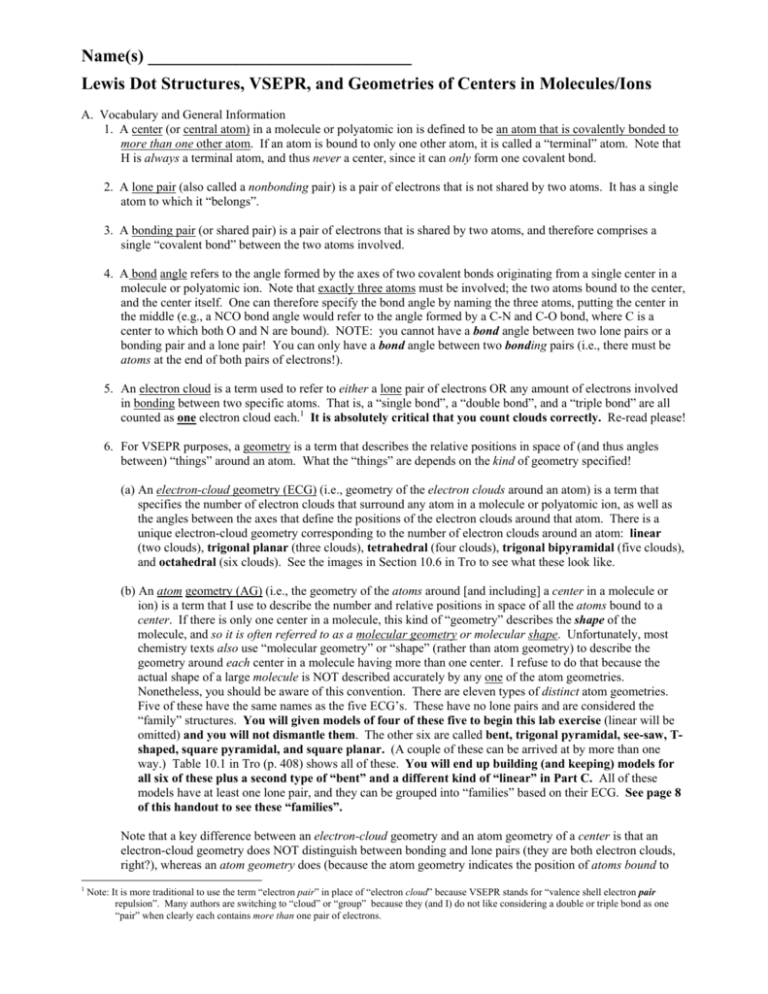
Name(s) ______________________________ Lewis Dot Structures, VSEPR, and Geometries of Centers in Molecules/Ions A. Vocabulary and General Information 1. A center (or central atom) in a molecule or polyatomic ion is defined to be an atom that is covalently bonded to more than one other atom. If an atom is bound to only one other atom, it is called a “terminal” atom. Note that H is always a terminal atom, and thus never a center, since it can only form one covalent bond. 2. A lone pair (also called a nonbonding pair) is a pair of electrons that is not shared by two atoms. It has a single atom to which it “belongs”. 3. A bonding pair (or shared pair) is a pair of electrons that is shared by two atoms, and therefore comprises a single “covalent bond” between the two atoms involved. 4. A bond angle refers to the angle formed by the axes of two covalent bonds originating from a single center in a molecule or polyatomic ion. Note that exactly three atoms must be involved; the two atoms bound to the center, and the center itself. One can therefore specify the bond angle by naming the three atoms, putting the center in the middle (e.g., a NCO bond angle would refer to the angle formed by a C-N and C-O bond, where C is a center to which both O and N are bound). NOTE: you cannot have a bond angle between two lone pairs or a bonding pair and a lone pair! You can only have a bond angle between two bonding pairs (i.e., there must be atoms at the end of both pairs of electrons!). 5. An electron cloud is a term used to refer to either a lone pair of electrons OR any amount of electrons involved in bonding between two specific atoms. That is, a “single bond”, a “double bond”, and a “triple bond” are all counted as one electron cloud each.1 It is absolutely critical that you count clouds correctly. Re-read please! 6. For VSEPR purposes, a geometry is a term that describes the relative positions in space of (and thus angles between) “things” around an atom. What the “things” are depends on the kind of geometry specified! (a) An electron-cloud geometry (ECG) (i.e., geometry of the electron clouds around an atom) is a term that specifies the number of electron clouds that surround any atom in a molecule or polyatomic ion, as well as the angles between the axes that define the positions of the electron clouds around that atom. There is a unique electron-cloud geometry corresponding to the number of electron clouds around an atom: linear (two clouds), trigonal planar (three clouds), tetrahedral (four clouds), trigonal bipyramidal (five clouds), and octahedral (six clouds). See the images in Section 10.6 in Tro to see what these look like. (b) An atom geometry (AG) (i.e., the geometry of the atoms around [and including] a center in a molecule or ion) is a term that I use to describe the number and relative positions in space of all the atoms bound to a center. If there is only one center in a molecule, this kind of “geometry” describes the shape of the molecule, and so it is often referred to as a molecular geometry or molecular shape. Unfortunately, most chemistry texts also use “molecular geometry” or “shape” (rather than atom geometry) to describe the geometry around each center in a molecule having more than one center. I refuse to do that because the actual shape of a large molecule is NOT described accurately by any one of the atom geometries. Nonetheless, you should be aware of this convention. There are eleven types of distinct atom geometries. Five of these have the same names as the five ECG’s. These have no lone pairs and are considered the “family” structures. You will given models of four of these five to begin this lab exercise (linear will be omitted) and you will not dismantle them. The other six are called bent, trigonal pyramidal, see-saw, Tshaped, square pyramidal, and square planar. (A couple of these can be arrived at by more than one way.) Table 10.1 in Tro (p. 408) shows all of these. You will end up building (and keeping) models for all six of these plus a second type of “bent” and a different kind of “linear” in Part C. All of these models have at least one lone pair, and they can be grouped into “families” based on their ECG. See page 8 of this handout to see these “families”. Note that a key difference between an electron-cloud geometry and an atom geometry of a center is that an electron-cloud geometry does NOT distinguish between bonding and lone pairs (they are both electron clouds, right?), whereas an atom geometry does (because the atom geometry indicates the position of atoms bound to 1 Note: It is more traditional to use the term “electron pair” in place of “electron cloud” because VSEPR stands for “valence shell electron pair repulsion”. Many authors are switching to “cloud” or “group” because they (and I) do not like considering a double or triple bond as one “pair” when clearly each contains more than one pair of electrons. the center [through bonding electrons]). Also, an ECG can be used to describe any atom in an LDS (a center or a terminal atom) whereas an AG only applies to a center. Since a atom geometry does distinguish between bonding and lone pairs, there are multiple atom geometries corresponding to a given number of electron clouds surrounding the center. If all of the electron clouds are bonding clouds (i.e., no lone pairs!), then the name of the atom geometry will be identical to the electron-cloud geometry that corresponds to that specific number of clouds. But if any of the electron clouds are lone pairs, the atom geometry will have a different name. For example, if there are three electron clouds surrounding a center, there are two possible atom geometries: trigonal planar, which would apply if all three clouds are bonding clouds (i.e., if there are three atoms bound to the center), and bent, which corresponds to the case where one of the clouds is a lone pair (i.e., if only two atoms are bound to the center). Note: the names of the atom geometries tend to reflect the “look” of the center and surrounding ATOMS, not any lone pairs, if present. One of your goals today will be to visualize this by looking at models of centers possessing all the various atom geometries. Note: remember that your text uses the term “molecular geometry” instead of “atom geometry”. B. Examining and familiarizing yourself with the “basic” atom geometries (the ones having the same names as the electron-cloud geometries (because there are no lone pairs). 1. Remove the pre-made single-centered structures from your container. For the sake of these exercises, each green “stick” represents a bonding cloud of electrons (imagine that there’s an atom at the other end). Red sticks are used to represent lone (“nonbonding”) pairs later when needed. 2. Find the structure that matches each sketch below, and write the proper name of the atom geometry below the sketch (use your text or class notes to get the names). If you are uncertain about why the name is what it is, ask me! It is important for you to become very familiar with these names, and they DO have some logic to them! (NOTE: I have left out “linear” here, but you are responsible for that as well). 3. Look closely at the way the dashed and solid wedges attempt to show the three-dimensional arrangement of the structures. Hold up the model to each drawing and rotate it around until you can “see” how to interpret the wedges and dashes so that you can visualize the 3D shape that the drawing is intending for you to see. Once you have done this “matching” for each structure, check off the box indicated. Note: You will need to be able to draw such structures yourself in this exercise, as well as on an exam, so use these drawings as “models” when you need to draw these geometries in the exercise today. 3. Write down the value(s) for the bond angles that characterize the geometry in each structure below (consult your text), and then examine the actual model to see if it appears to match the angle it is “supposed” to have. O O O O O O O O O O O O O O O O O O O O O O Write the name of the atom geometry depicted: I have physically and visually “matched” the model with the drawing so I can see how the wedges indicate threedimensionality. (Check each box as you go.) Write the bond angle(s) in this atom geometry: 2 C. Generating and analyzing the atom geometries that involve lone pairs. NOTE: DO NOT DISMANTLE ANY MODEL UNLESS SPECIFICALLY TOLD TO DO SO. AT THE END OF PART C, YOU SHOULD HAVE TWELVE COMPLETED MODELS TO ANALYZE/HANDLE. 1. In the Trigonal Planar Family (3 charge clouds): "Bent". Use the extra pieces provided to make a replica of the trigonal planar model. Remove one of the green sticks from this trigonal planar model, and replace it with a red stick (lone pair). This represents the atom geometry called “bent” (or “angular” or “V-shaped”). (Can you see why?) Remember that the atom geometry name generally arises from the “look” of the ATOMS rather than the lone pairs. Sketch a picture of this atom geometry, including the lone pair. Draw the Lewis dot structure (LDS) for SO2, which has this atom geometry, and see how it corresponds to your sketch of "bent". Sketch of “Bent”, with lone pairs and angles shown Lewis Structure Asked For 2. In the Tetrahedral Family (4 charge clouds): "Trigonal Pyramidal" and "Bent" To start off, build two additional tetrahedral models (use extra pieces). a. Remove one green stick (bonding pair) from one of the tetrahedral models and replace it with a short red stick (lone pair). This model now represents the atom geometry called trigonal pyramidal. (Can you see why?) Sketch this atom geometry. Draw the LDS for NH3, which has this atom geometry, and see how it corresponds to your sketch of "trigonal pyramidal". Sketch of “Trigonal Pyramidal”, with lone pairs and angles Lewis Structure Asked For b. Remove two green sticks off of the second tetrahedral model, and replace them with red sticks. This atomic arrangement should look familiar--it is called “bent”! However, in this "version" of "bent", the bond angle is not 120, because there are four charge clouds instead of three. Sketch this geometry, showing the two lone pairs. Draw the LDS for H2O, which has this atom geometry, and see how it corresponds to your sketch of "bent". Sketch of “Bent” (as others) Lewis Structure Asked For 3 3. In the Trigonal Bipyramidal Family (5 charge clouds): "See Saw", "T-Shaped", and "Linear" To start off, build three additional models of the trigonal bipyramidal geometry. a. Are all the bonding clouds identical in this geometry? You should see that they are not! There are three “equatorial” bonding clouds and two “axial” ones. Remove an axial bonding cloud from one of the replicas and replace it with a lone pair. Using a second replica, remove an equatorial bonding cloud and replace it with a lone pair. Compare the two models that you just made (that each have a single lone pair). Given that a lone pair is held more closely to the center and therefore “pushes harder” on the other electron clouds, which model represents the one with the least amount of “repulsion”? Note that it is the 90 interactions that cause the “worst” repulsion interaction--the 120 interactions are much less “unfavorable”. Sketch the one that you consider the “preferable” one (showing the lone pair), which should be the one called “see saw”. (Can you see why it has this name?! Remember this!) Draw the LDS for SF4, which has this atom geometry, and see how it corresponds to your sketch of "see saw". Sketch of “See Saw” (as others) Lewis Structure Asked For b. Rearrange the sticks as needed on the “non-see-saw” model from the prior exercise (don’t dismantle the seesaw one!) to make it look identical to the see-saw model. Then remove an equatorial bonding cloud on this model and replace it with a lone pair (for the same reasons as above in (a)). This atom geometry is called “Tshaped”, and I hope you can see why!! Draw the LDS for ClF3, which has this atom geometry, and see how it corresponds to your sketch of "T-shaped". Sketch of “T-Shaped” (as others) Lewis Structure Asked For c. If you were going to replace three bonding clouds with lone pairs (using the third model of trigonal bipyramidal), which would you replace? This atom geometry is called “linear” (yep, this is a second way to get “linear”!). Sketch this (along with lone pairs) below, and draw the Lewis structure for XeF2, which has this atom geometry. Sketch of “Linear” (as others) Lewis Structure Asked For 4 4. In the Octahedral Family (6 charge clouds): "Square Pyramidal" and "Square Planar" To start, make two additional replicas of the octahedral geometry. a. Remove one bonding cloud from one of the replicas and replace with a lone pair. Sketch it, as well as the Lewis dot structure for BrF5, which has one lone pair, and see how they correspond. This atom geometry is called “square pyramidal”. Can you see why? Sketch of “Square Pyramidal” (as others) Lewis Structure Asked For b. Since all of the positions are identical in an octahedral geometry, it is best to place two lone pairs, if present, as far away from each other as possible (i.e., across from each other). Using the second model, replace two bonding clouds that lie across from one another with lone pairs. This geometry is called “square planar” (Can you see why?). Sketch this, as well as the Lewis structure for XeF4, which has two lone pairs, and see how they correspond. Sketch of “Square Planar” (as others) Lewis Structure Asked For PART C SUMMARY EXERCISE: GO TO BACK PAGE NOW (then come back to do parts D & E) D. Small Molecule (one center only) Examples Determine the electron cloud geometry and atom geometry of the centers in the following, and then sketch the species. Include ATOMS, lone pairs and specify the bond angles. Also, use wedges and dashes as needed. 1. HClO, H O (Note: in ACIDS, the H is nearly always bound to an O! This “forces” the O to be in the center in this case even though it is more electronegative than Cl!) Cl Sketch (with ATOMS, lone pairs and bond angles shown) # of electron clouds around the center: _____ ECG:___________________________ AG:____________________________ + F 2. ClF4+, F Cl Sketch (w/ATOMS, lone pairs and bond angles shown) F F # of electron clouds around the center: _____ ECG:___________________________ AG:____________________________ 5 3. O3 (draw the Lewis structure for this one yourself! Make sure you double check your Lewis structure!) Lewis Structure: Sketch (w/atoms, lone pairs and bond angles shown) # of electron clouds around the center: _____ ECG:___________________________ AG:____________________________ 4. KrF4 (draw the Lewis structure) Lewis Structure: Sketch (w/atoms, lone pairs and bond angles shown) # of electron clouds around the center: _____ ECG:___________________________ AG:____________________________ 5. H2CO (draw the Lewis structure) Lewis Structure: Sketch (w/atoms, lone pairs and bond angles shown) # of electron clouds around the center: _____ ECG:___________________________ AG:____________________________ E. Larger molecules State the atom geometries of each center in the following molecules, and determine the bond angles indicated. BUILD THE MOLECULE WITH MOLECULAR MODELS IF INDICATED. H 1. H C1 AG(C1):____________________________ C2 N H HCH bond angle:_________ AG(C2):____________________________ HCC bond angle: ________ 6 CCN bond angle: ________ 2. CHBr=CHCH3. A structural formula is: H Br H H C1 C2 C3 H H Complete the sketch of this one (w/proper wedges and dashes to show geometry): C2 H H C3 H H AG’s: C1:_________________________ C2: _________________________ C3: _________________________ HC1Br bond angle:_______ BrC1C2 bond angle: _______ C2C3H bond angle: _______ HC3H bond angle: _______ 3. Note: You must add lone pairs as needed in the structure below! Also, if time, BUILD THIS ONE! F H H C5 H C4 Cl AG(C5):____________________________ F-C5-H angle:__________ AG(C2):____________________________ H-C2-H angle:__________ AG(O):____________________________ N H C3 O C2 C1 H O H H C3 -O-H angle:__________ AG(C4):____________________________ C5-C4-C3 angle:__________ ANALYZE CLOSELY THE SPACE-FILLING MODEL, IF PROVIDED, FOR THIS MOLECULE. Do you see why I don’t like the term “molecular geometry”? You cannot describe the geometry of this molecule in one word or phrase, can you??? Do the following after these topics have been discussed in class [may be after actual lab period] (a) State the total number of sigma bonds and pi bonds in this molecule. :_______ :________ (b) State the hybrid orbitals used by each of the four centers identified above to make sigma bonds: AG(C5):_____________ AG(C2):______________ AG(O):______________ AG(C4):_______________ (c) State the orbitals used for pi bonding for the centers that involve pi bonds. 7 Part C—SUMMARY EXERCISE: Fill in the table below (with name and sketch of the appropriate atom geometry), and then physically ARRANGE ALL YOUR MODELS ON YOUR DESKTOP in the order indicated below. Take some time to study these as follows: Convince yourself that you can easily determine the “atom geometry” for a center in a Lewis dot structure as follows: 1) identify which “family” (column) you’re in (EC geometry) by counting the number of total electron clouds around the center, and then 2) (in your mind) remove one “atom/bond” for each lone pair on the center in the Lewis structure (which in the table corresponds to moving “down” one row). DO NOT DISMANTLE YOUR MODELS. Use them to help you do the questions in part D. At some point in time before you leave lab, you must show your models (in this order) to your instructor along with the filled in table below. NOTE: Each “O” below is meant to represent an atom (not the symbol for the element “oxygen”). If I could have colored them in black, I would have. You may write solid spheres to represent atoms in your structures. # of e- clouds NO lone pairs ( “Parent” Structure) 3 4 Trigonal Planar “Family” Tetrahedral Trigonal Planar Tetrahedral Trigonal Bipyramidal Octahedral ______________ ______________ Square Pyramidal O O O O “Family” 5 Trigonal Bipyramidal 6 Octahedral “Family” “Family” O O ______________ ONE lone pair O O O O O O O O O Bent ______________ ______________ O TWO lone pairs (N/A) O O O O O O ______________ THREE lone pairs (N/A) (N/A) (N/A) 8
